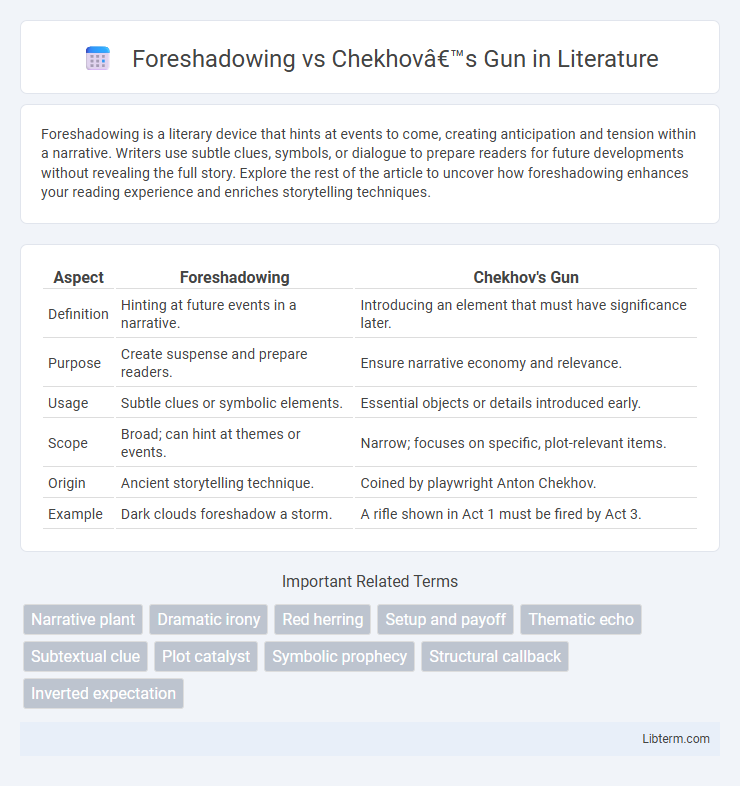Foreshadowing is a literary device that hints at events to come, creating anticipation and tension within a narrative. Writers use subtle clues, symbols, or dialogue to prepare readers for future developments without revealing the full story. Explore the rest of the article to uncover how foreshadowing enhances your reading experience and enriches storytelling techniques.
Table of Comparison
| Aspect | Foreshadowing | Chekhov's Gun |
|---|---|---|
| Definition | Hinting at future events in a narrative. | Introducing an element that must have significance later. |
| Purpose | Create suspense and prepare readers. | Ensure narrative economy and relevance. |
| Usage | Subtle clues or symbolic elements. | Essential objects or details introduced early. |
| Scope | Broad; can hint at themes or events. | Narrow; focuses on specific, plot-relevant items. |
| Origin | Ancient storytelling technique. | Coined by playwright Anton Chekhov. |
| Example | Dark clouds foreshadow a storm. | A rifle shown in Act 1 must be fired by Act 3. |
Understanding Foreshadowing: Definition and Techniques
Foreshadowing is a literary technique used to hint at future events in a story, creating anticipation and building suspense for readers. It employs subtle clues, symbols, or dialogue that suggest what might happen later, enhancing narrative cohesion and emotional impact. Unlike Chekhov's Gun, which mandates that every introduced element must be significant, foreshadowing can provide thematic resonance without immediate payoff.
What Is Chekhov’s Gun? Core Principles Explained
Chekhov's Gun is a dramatic principle that dictates every element introduced in a story must have relevance and purpose, ensuring that seemingly minor details will become significant later in the narrative. Core principles emphasize narrative economy and preventing extraneous information, requiring that objects or details must contribute directly to the plot's development or character outcomes. This principle promotes tight storytelling by making every introduced item a "gun" that metaphorically must go off, distinguishing it from general foreshadowing which can be broader and less immediately consequential.
Key Differences Between Foreshadowing and Chekhov’s Gun
Foreshadowing hints at future events indirectly, creating suspense and thematic depth without revealing specific outcomes, while Chekhov's Gun mandates that every introduced element must have a clear purpose in the story's resolution. Foreshadowing can be broad and symbolic, allowing for multiple interpretations, whereas Chekhov's Gun functions as a precise narrative tool ensuring narrative economy by eliminating extraneous details. The key difference lies in foreshadowing's role in mood-building and anticipation, contrasted with Chekhov's Gun's demand for narrative payoff and tight plot construction.
The Purpose of Foreshadowing in Storytelling
Foreshadowing in storytelling serves to build anticipation and create a sense of cohesion by hinting at future events, enriching the narrative with subtle clues that prepare the audience emotionally and cognitively. Unlike Chekhov's Gun, which demands that every introduced element must be essential and used later, foreshadowing allows for thematic or symbolic cues that may not directly affect the plot but enhance the story's depth and meaning. Effective foreshadowing increases reader engagement and satisfaction by providing a framework through which plot twists and character developments feel both surprising and inevitable.
How Chekhov’s Gun Shapes Narrative Economy
Chekhov's Gun shapes narrative economy by ensuring every element introduced in a story is purposeful and integral to the plot's progression. Unlike general foreshadowing, which hints at future events to create suspense, Chekhov's Gun demands precise and efficient storytelling where no detail is superfluous. This technique trims narrative excess, streamlines character development, and builds tension by promising payoff, thereby maintaining tight pacing and reader engagement.
Subtle vs. Direct: Foreshadowing and Chekhov’s Gun in Practice
Foreshadowing employs subtle hints and clues, creating anticipation through indirect references that may only become clear later in the narrative. Chekhov's Gun operates with direct narrative economy, ensuring every introduced element has a clear, essential purpose revealed when it becomes crucial. Both techniques enhance storytelling by guiding audience expectations, with foreshadowing favoring nuanced immersion and Chekhov's Gun demanding concise relevance.
Famous Examples of Foreshadowing in Literature and Film
Foreshadowing subtly hints at future plot developments, exemplified by the ominous storm in Shakespeare's *Macbeth* which signals impending chaos, and the recurring yellow wallpaper in Charlotte Perkins Gilman's *The Yellow Wallpaper* that reveals the narrator's descent into madness. In film, the green light in *The Great Gatsby* symbolizes Gatsby's unattainable dreams, while the opening scene of *Jaws* foreshadows the terror lurking beneath the water. These literary and cinematic examples enhance suspense and thematic depth by preparing audiences for significant narrative turns.
Memorable Uses of Chekhov’s Gun Across Media
Chekhov's Gun is a narrative principle emphasizing that every element introduced in a story must have significance, ensuring memorable impact when the seemingly minor detail becomes crucial later in films like *The Sixth Sense* or literature such as Arthur Conan Doyle's Sherlock Holmes stories. Unlike foreshadowing, which subtly hints at future events, Chekhov's Gun demands a direct, purposeful insertion of objects or details that ultimately drive the plot or character development. Iconic uses include the red coat in *Schindler's List* and the voice recorder in *Reservoir Dogs*, demonstrating how purposeful objects maintain narrative cohesion and heighten audience engagement.
When to Use Foreshadowing vs. Chekhov’s Gun in Writing
Foreshadowing is best used when subtle hints or atmospheric clues build anticipation and mood over time, enhancing the story's suspense without revealing specific outcomes. Chekhov's Gun should be applied when an object, detail, or element introduced must have a clear, significant impact later in the narrative, ensuring every detail serves a defined purpose. Writers strategically employ foreshadowing for thematic depth and emotional tension, while Chekhov's Gun demands narrative economy and precise plot relevance.
Enhancing Plot Impact: Blending Foreshadowing with Chekhov’s Gun
Blending foreshadowing with Chekhov's Gun enhances plot impact by subtly planting clues that become crucial later, creating a satisfying narrative payoff. Foreshadowing builds anticipation and mood, while Chekhov's Gun ensures every detail serves a purpose, avoiding unnecessary elements. This synergy deepens audience engagement by making story developments feel both inevitable and surprising.
Foreshadowing Infographic

 libterm.com
libterm.com